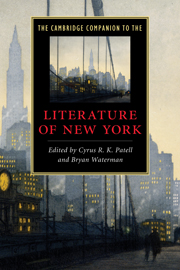Book contents
- Frontmatter
- Introduction
- 1 From British outpost to American metropolis
- 2 Dutch New York from Irving to Wharton
- 3 The city on stage
- 4 Melville, at sea in the city
- 5 Whitman’s urbanism
- 6 The early literature of New York’s moneyed class
- 7 Writing Brooklyn
- 8 New York and the novel of manners
- 9 Immigrants, politics, and the popular cultures of tolerance
- 10 Performing Greenwich Village bohemianism
- 11 African American literary movements
- 12 New York’s cultures of print
- 13 From poetry to punk in the East Village
- 14 Staging lesbian and gay New York
- 15 Emergent ethnic literatures
- Further reading
- Index
- Series list
3 - The city on stage
Published online by Cambridge University Press: 28 November 2010
- Frontmatter
- Introduction
- 1 From British outpost to American metropolis
- 2 Dutch New York from Irving to Wharton
- 3 The city on stage
- 4 Melville, at sea in the city
- 5 Whitman’s urbanism
- 6 The early literature of New York’s moneyed class
- 7 Writing Brooklyn
- 8 New York and the novel of manners
- 9 Immigrants, politics, and the popular cultures of tolerance
- 10 Performing Greenwich Village bohemianism
- 11 African American literary movements
- 12 New York’s cultures of print
- 13 From poetry to punk in the East Village
- 14 Staging lesbian and gay New York
- 15 Emergent ethnic literatures
- Further reading
- Index
- Series list
Summary
Something which concerns themselves
The French traveler and critic Alexis de Tocqueville likely had in mind New York City theaters like the Bowery and the Park when he wrote, in Democracy in America (1835), that
[a]t the theater alone, the higher ranks mix with the middle and lower classes; there alone do the former consent to listen to the opinion of the latter, or at least to allow them to give an opinion at all. At the theater men of cultivation and of literary attainments have always had more difficulty than elsewhere in making their taste prevail over that of the people and in preventing themselves from being carried away by the latter. The pit has frequently made laws for the boxes.
Tocqueville's description indicates the ways in which the early theater in New York (as in larger cities such as London or Paris) both accommodated all classes and segregated them in carefully demarcated architectural spaces, the “pit” on the floor and the private “boxes” - belonging to wealthy subscribers - above and to the sides. He doesn't mention the third space common to early New York theaters, the “gallery,” made up of balcony seating that reached up to nosebleed heights, including a “third tier” that often housed prostitutes and their customers. The “gallery gods,” young workingclass patrons, were commonly understood to rule theaters by threatening to shower food or even furniture on performers or viewers in other portions of the house.
- Type
- Chapter
- Information
- The Cambridge Companion to the Literature of New York , pp. 42 - 57Publisher: Cambridge University PressPrint publication year: 2010



